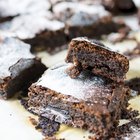
Moving to a new city at a higher altitude presents a few challenges, from physical fatigue to reworking your favorite recipes. The lower air pressure and thin, dry air at higher elevations can do strange things to your baked goods, even relatively simple baked goods such as brownies. They're less prone to failure than rich, delicate cakes, but getting them to behave might require a few test batches. Chances are you'll need to alter both temperature and ingredients along the way.
Step 1
Contact your local county extension office, and find out exactly how high above sea level you are. Most recipes will work up to about 3,000 feet without alteration, but the higher you go, the more they'll need to be adjusted.
Step 2
Bake a test batch of your brownies without altering the recipe, and evaluate the results. Sometimes your original recipe is forgiving enough that it won't need to be changed. If it's dry, if the texture has changed or if your brownies rose and then fell, you'll need to try a few alterations.
Step 3
Bake your brownies at a slightly higher temperature, increasing the oven's heat by 15 to 25 degrees Fahrenheit. Shorten the baking time to compensate, leaving your brownies in the oven 8 minutes for every 10 minutes specified in the recipe. In many cases, hotter and faster baking will correct the brownies' texture adequately without further changes.
Step 4
Reduce the leavening if your brownies rise too much, or rise and then fall. Cut back your baking soda or baking powder by 1/8 to 1/4 teaspoon, and don't beat the fat and sugar as long. Baked goods rise quickly at high altitude, and will dry out if you use too much leavening.
Step 5
Increase the moisture in your recipe by adding extra milk or an additional egg yolk. Alternatively, use an extra-large egg instead of a large egg. The added liquid helps keep your brownies moist, and the extra egg will provide structure to the brownies' crumb.
Related Articles

How Long to Bake Brownies Using Molds?

How to Replace Ingredients to Make ...
How to Bake Cupcakes at High Altitudes
How to Make Homemade Pancakes Without ...

How to Prepare French Toast in Advance

How to Make a Tasty Drink for Kids From ...

Substitutes for Vegetable Oil in ...

How to Freeze Empanadas

Instructions for a Cosco High Chair

What Happens When You Forget to Put ...

How Many Calories Are in a Bagel With ...

How to Size Foamposite

How to Bake Custard in Ramekins
How to Substitute Applesauce for Butter ...

How to Prepare & Cook Smoked Jowl

Inches to Shoe Size Conversion

How to Make Boxed Chocolate Cake Better

How Long Do You Have to Beat Frosting ...

How to Replace Milk and Butter in Baked ...

How to Use Bread to Soften Brownies
References
Resources
Tips
- Chocolate-rich baked goods such as brownies can scorch or burn if you bake them at too high a temperature, so if you find that 25 degrees is too much of an increase, reduce the oven's heat after the first few minutes.
- Baked goods tend to stick more at high altitudes, so grease your pans well or line them with parchment paper to make the brownies easier to remove.
- If your brownies come out too dense, you might also need to reduce the fat and sugar in your recipe, but the opposite is more likely to be the case.
Writer Bio
Fred Decker is a trained chef and prolific freelance writer. In previous careers, he sold insurance and mutual funds, and was a longtime retailer. He was educated at Memorial University of Newfoundland and the Northern Alberta Institute of Technology. His articles have appeared on numerous home and garden sites including GoneOutdoors, TheNest and eHow.
Photo Credits
Jupiterimages/Photos.com/Getty Images